Stability Analysis of “321” Prefabricated Highway Steel Truss Bridge
Abstract
:1. Introduction
2. Structural Composition and Characteristics
3. Stability Analysis of Truss Chord
4. Stability Analysis of Truss Diagonal Member
5. Stability Analysis of Truss Vertical Bar
6. Conclusions
- (1)
- The maximum internal force of truss chords (including stiffening chords), truss diagonal members, and truss vertical bars under eccentrically distributed load is greater than their maximum internal force under centered-layout load. Therefore, the vehicle shall be driven in the middle when passing through a “321” prefabricated steel truss bridge.
- (2)
- Under the centered-layout load, the maximum internal force of the truss chord (including the stiffening chord) appears at the middle span section. Under the eccentrically distributed load, the maximum internal force of the truss chord (including the stiffening chord) appears at the middle span section, which is the nearest position to vehicle loading. The maximum internal force of the stiffening chord shall be greater than the maximum internal force of the corresponding truss chord. Under vehicle load, truss chords (including stiffening chords) are prone to buckling instability and the buckling mode is mainly reverse out-of-plane buckling.
- (3)
- The stress and internal force distribution characteristics of truss inclined members and truss vertical bars are similar. Under the centered-layout load, the maximum internal forces of the truss diagonal members and truss vertical bars appear at the fulcrum joints. Under the eccentrically distributed load, the maximum internal forces of the truss diagonal members and truss vertical bars appear at the fulcrum node, which is the nearest position to vehicle loading.
- (4)
- Under vehicle load, the truss diagonal members are prone to buckling instability. The buckling mode is mainly a combination of out-of-plane bending and two-way out-of-plane bending.
- (5)
- The internal force of the truss vertical bar is less than its allowable bearing capacity, and it is not easy to buckle and lose stability. The truss vertical bar has good stability.
- (6)
- Some experiments are needed in future work to verify the conclusions drawn from this research.
Author Contributions
Funding
Data Availability Statement
Acknowledgments
Conflicts of Interest
References
- Burroughs, D.; Price, K. High performance steel bridge concepts. Mod. Steel Constr. 1999, 39, 45–52. [Google Scholar]
- Han, Q.; Du, X.; Liu, J.; Li, Z.; Li, L.; Zhao, J. Seismic damage of highway bridges during the 2008 Wenchuan earthquake. Earthq. Eng. Eng. Vib. 2009, 8, 263–273. [Google Scholar] [CrossRef]
- Barker, M.G.; Schrage, S.D. High performance steel: Design and cost comparisons. Mod. Steel Constr. 2000, 40, 35–41. [Google Scholar] [CrossRef]
- Mertz, D.R.; Hartmann, J.L. Evolution vs. revolution: The culture of steel bridge construction. In Proceedings of the Structures Congress XV, Portland, OR, USA, 13–16 April 1997; Structural Engineering Institute of the American Society of Civil Engineers: Reston, VA, USA, 1997; pp. 403–407. [Google Scholar]
- Horton, R.; Power, E.; Van Ooyen, K.; Azizinamini, A. High performance steel cost comparison study. Transp. Res. Rec. 2002, 1814, 27–36. [Google Scholar] [CrossRef]
- Wilson, A.D. Properties of recent production of A709 HPS-70W bridge steels. In Proceedings of the International Symposium on Steel from Fabricated Structures, Hong Kong, China, 15–17 December 1999. [Google Scholar]
- Zhang, Y.; Li, B. Application of ANSYS to reliability analysis of prefabricated steel bridge. J. Syst. Simul. 2015, 27, 1907–1913. [Google Scholar]
- Macioce, T.P.; Thompson, B.G.; Zielinski, B.J. Pennsylvania’s experience and future plans for high performance steel bridges. In Steel Bridge Design and Construction for the New Millennium with Emphasis on High Performance Steel: Conference Proceedings; National Bridge Research Organization: Lincoln, NE, USA, 2000; pp. 146–156. [Google Scholar]
- Yin, H.; Shi, G. Finite element analysis on the seismic behavior of fully prefabricated steel frames. Eng. Struct. 2018, 173, 28–51. [Google Scholar] [CrossRef]
- Bonopera, M.; Chang, K.C.; Chen, C.C.; Lin, T.K.; Tullini, N. Bending tests for the structural safety assessment of space truss members. Int. J. Space Struct. 2018, 33, 026635111880412. [Google Scholar] [CrossRef]
- Maes, K.; Peeters, J.; Reynders, E.; Lombaert, G.; De Roeck, G. Identification of axial forces in beam members by local vibration measurements. J. Sound Vib. 2013, 332, 5417–5432. [Google Scholar] [CrossRef]
- Wasserman, E.; Pate, H. Tennessee’s experience with high performance steel: An owner’s perspective. In Steel Bridge Design and Construction for the New Millennium with Emphasis on High Performance Steel: Conference Proceedings; National Bridge Research Organization: Lincoln, NE, USA, 2000; p. 138d145. [Google Scholar]

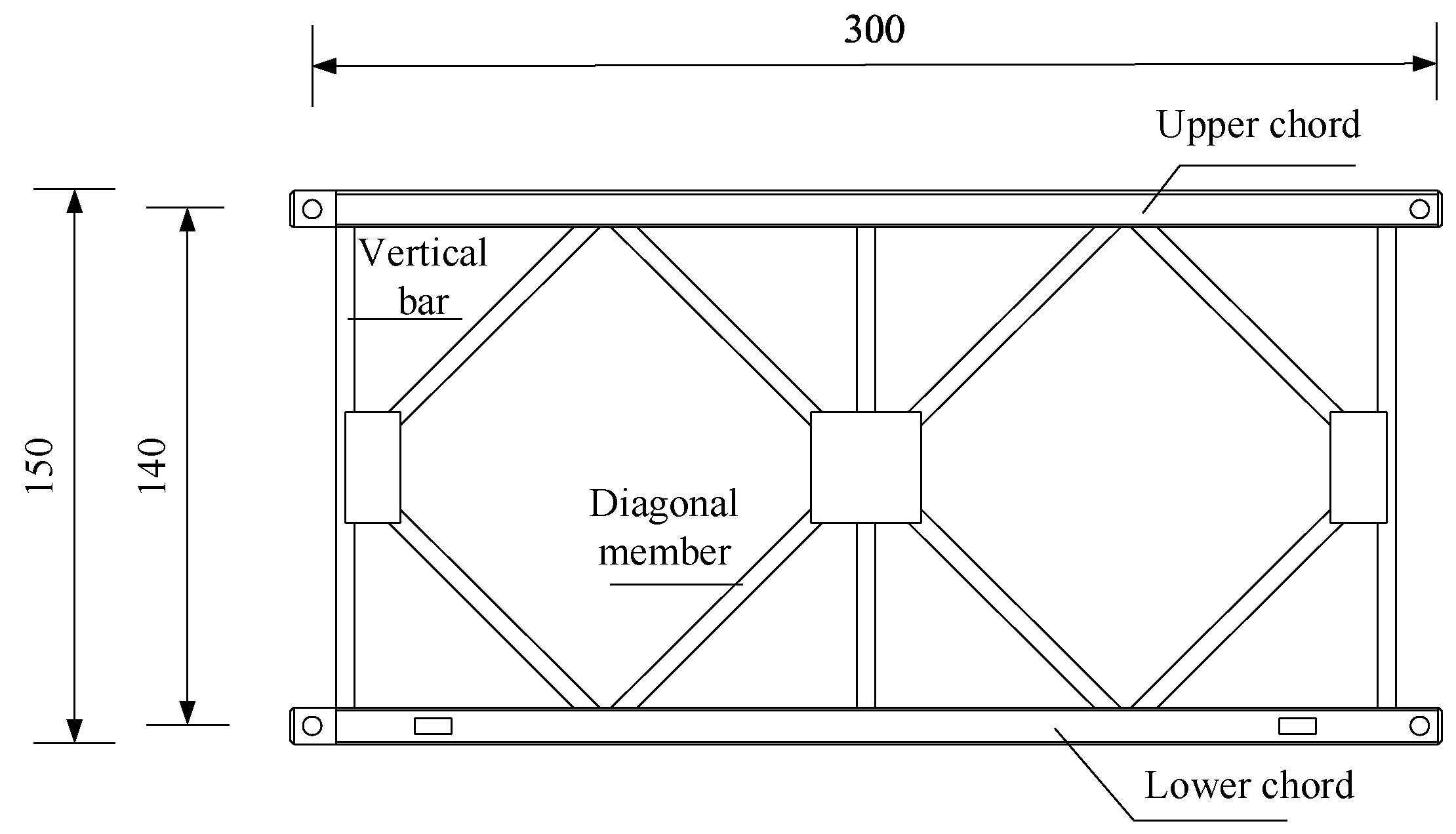


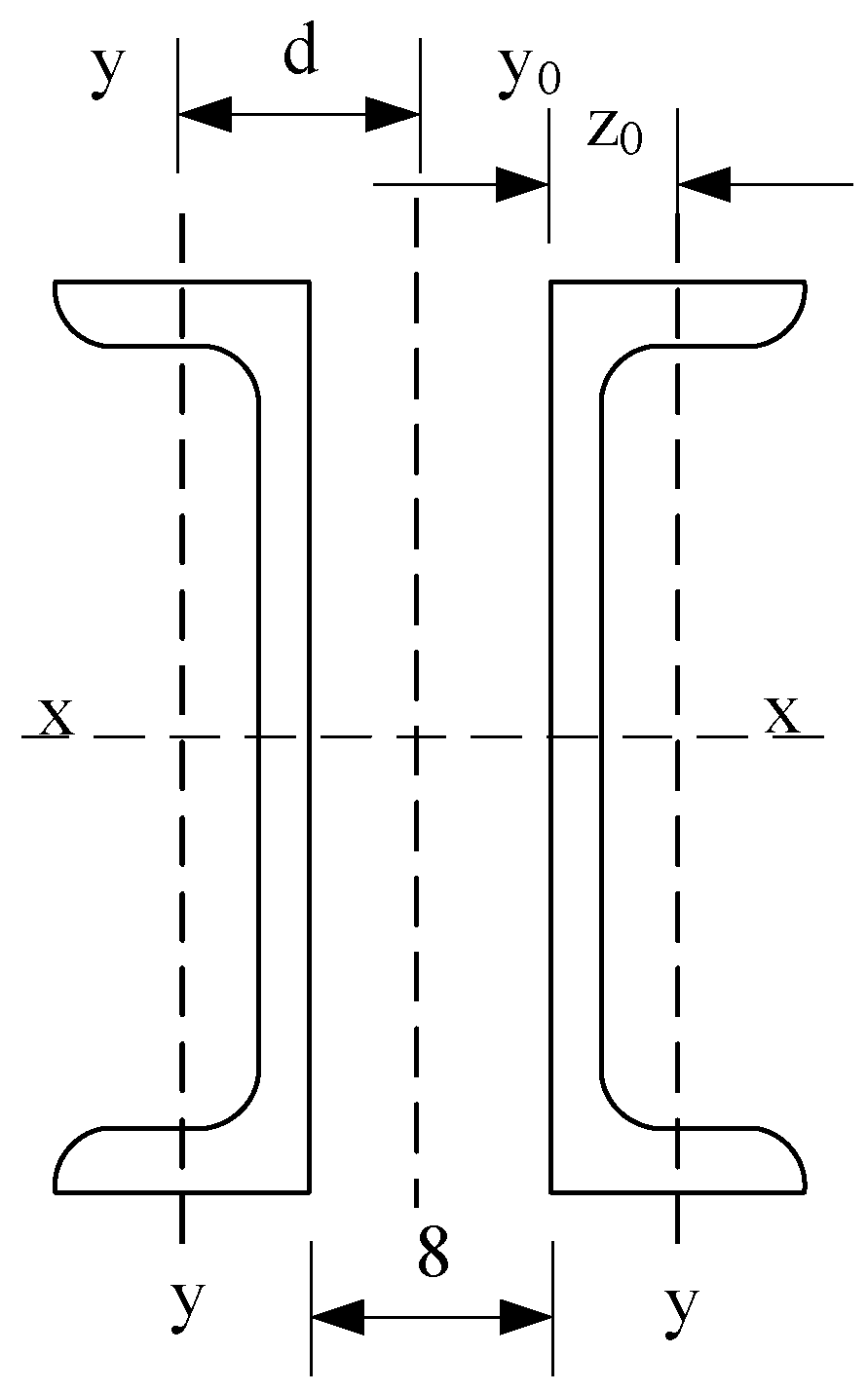
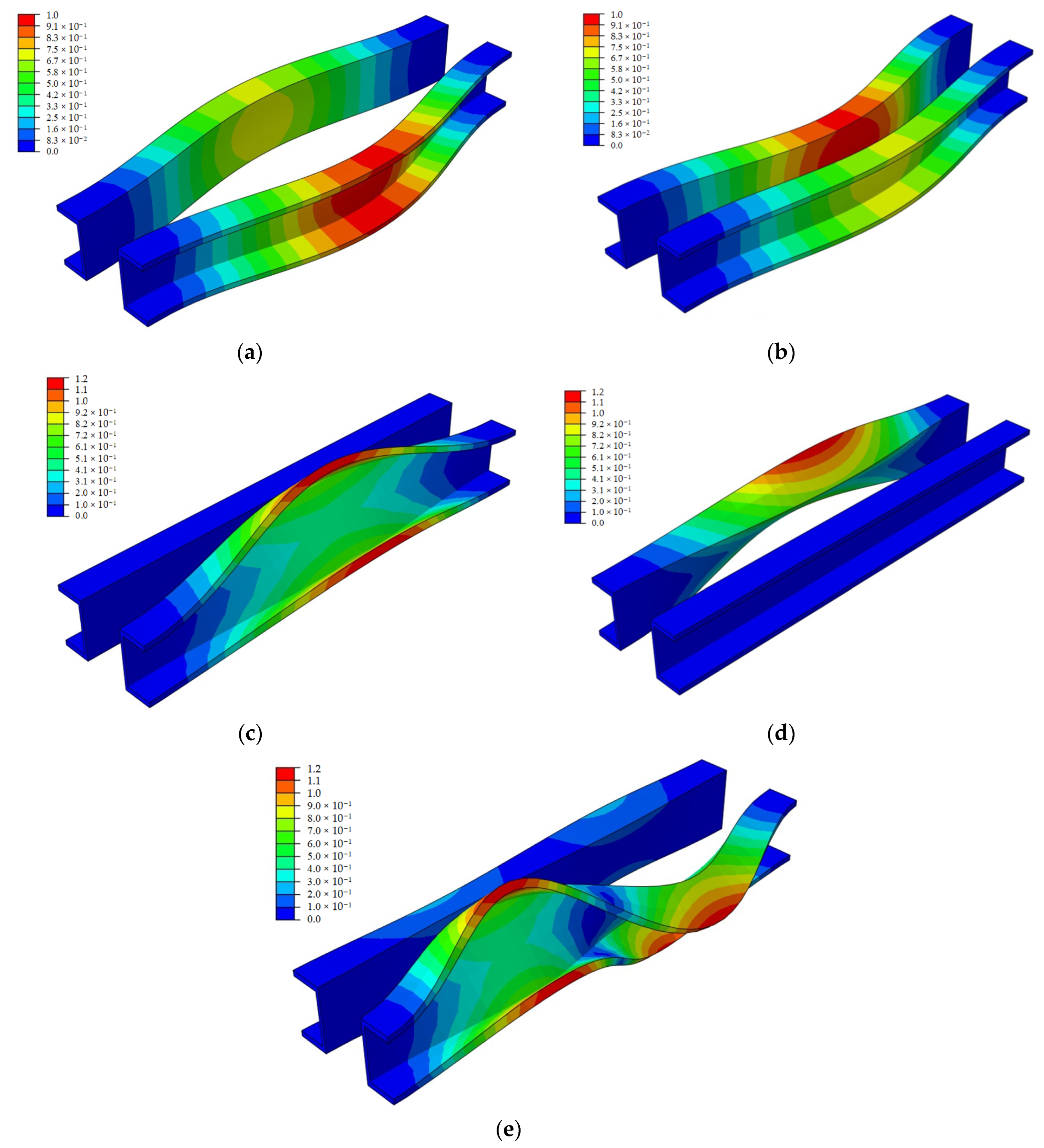
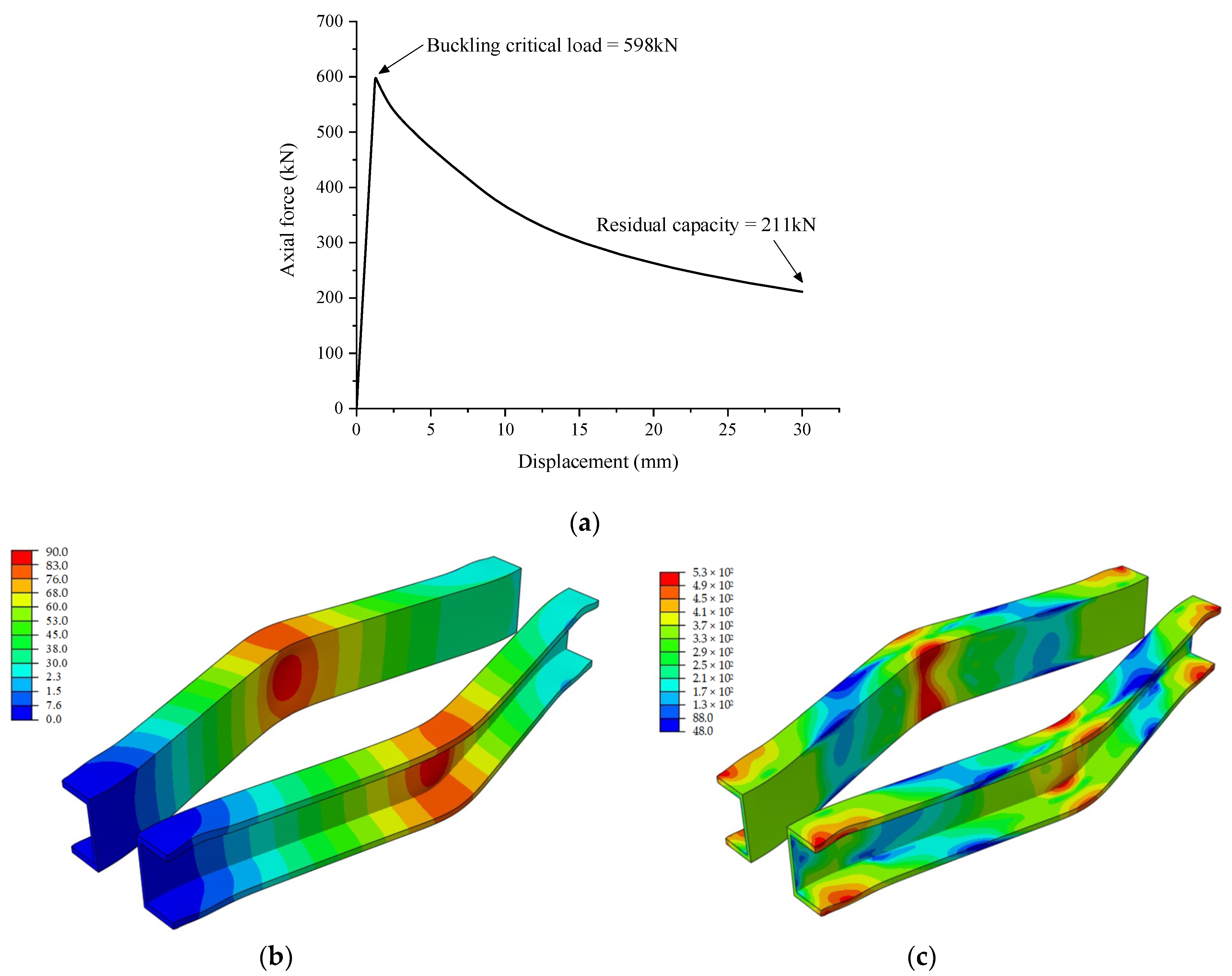
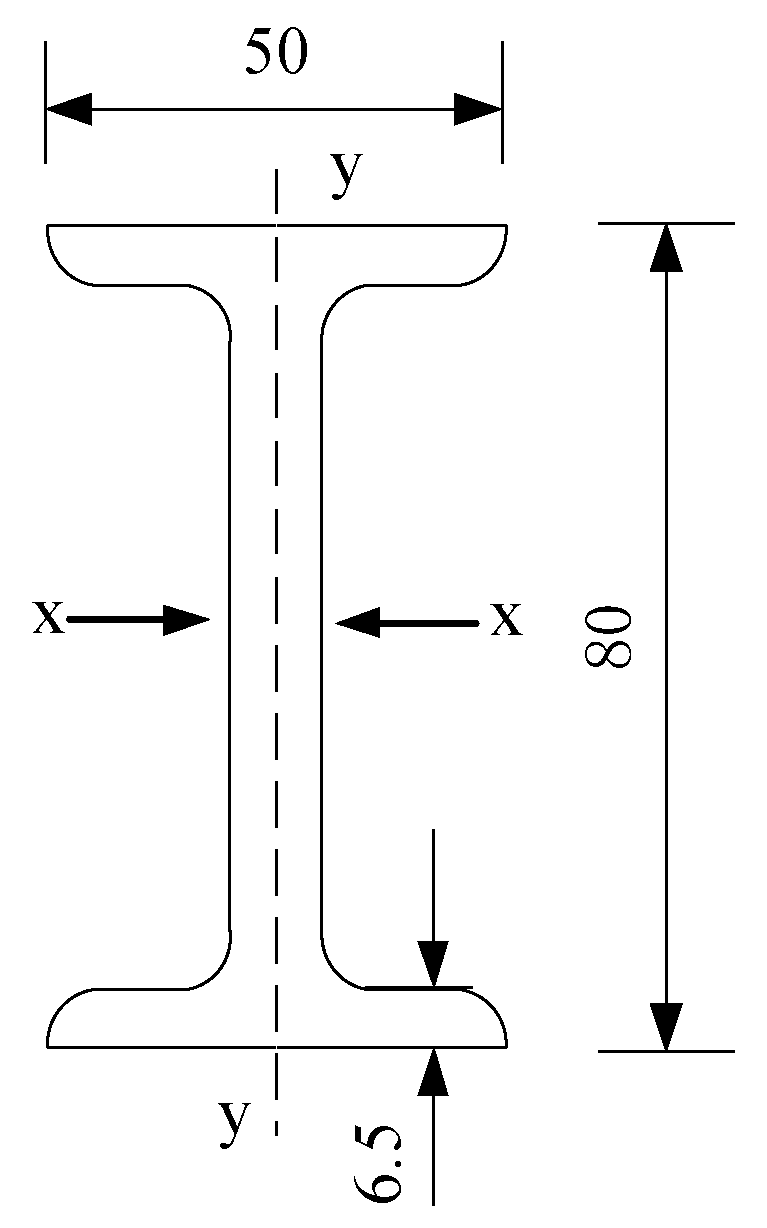


| Elastic Modulus (MPa) | Shear Modulus (MPa) | Coefficient of Linear Expansion (1/°C) | Poisson’s Ratio | Density (kg/m3) |
|---|---|---|---|---|
| 2.06 × 105 | 0.790 × 105 | 12 × 10−6 | 0.31 | 7850 |
| Condition | Row | Section | Maximum Axial Force of Lower Chord (Tension)/kN | Minimum Axial Force of Upper Chord (Compression)/kN |
|---|---|---|---|---|
| Medium Load | 1 | 6 | 479.3 | −536.7 |
| 2 | 6 | 497.3 | −553.3 | |
| 3 | 6 | 497.3 | −553.3 | |
| 4 | 6 | 479.4 | −536.8 | |
| Eccentrically distributed load | 1 | 6 | 402.3 | −460.5 |
| 2 | 6 | 429.1 | −467.1 | |
| 3 | 6 | 590.1 | −660.3 | |
| 4 | 6 | 557.4 | −613.0 |
Disclaimer/Publisher’s Note: The statements, opinions and data contained in all publications are solely those of the individual author(s) and contributor(s) and not of MDPI and/or the editor(s). MDPI and/or the editor(s) disclaim responsibility for any injury to people or property resulting from any ideas, methods, instructions or products referred to in the content. |
© 2024 by the authors. Licensee MDPI, Basel, Switzerland. This article is an open access article distributed under the terms and conditions of the Creative Commons Attribution (CC BY) license (https://creativecommons.org/licenses/by/4.0/).
Share and Cite
He, H.; Zhou, Y.; Cheng, S.; An, N.; Liu, H.; Fei, Z. Stability Analysis of “321” Prefabricated Highway Steel Truss Bridge. Buildings 2024, 14, 1626. https://doi.org/10.3390/buildings14061626
He H, Zhou Y, Cheng S, An N, Liu H, Fei Z. Stability Analysis of “321” Prefabricated Highway Steel Truss Bridge. Buildings. 2024; 14(6):1626. https://doi.org/10.3390/buildings14061626
Chicago/Turabian StyleHe, Haifang, Yulong Zhou, Shoushan Cheng, Ning An, Hongyi Liu, and Zhixuan Fei. 2024. "Stability Analysis of “321” Prefabricated Highway Steel Truss Bridge" Buildings 14, no. 6: 1626. https://doi.org/10.3390/buildings14061626









